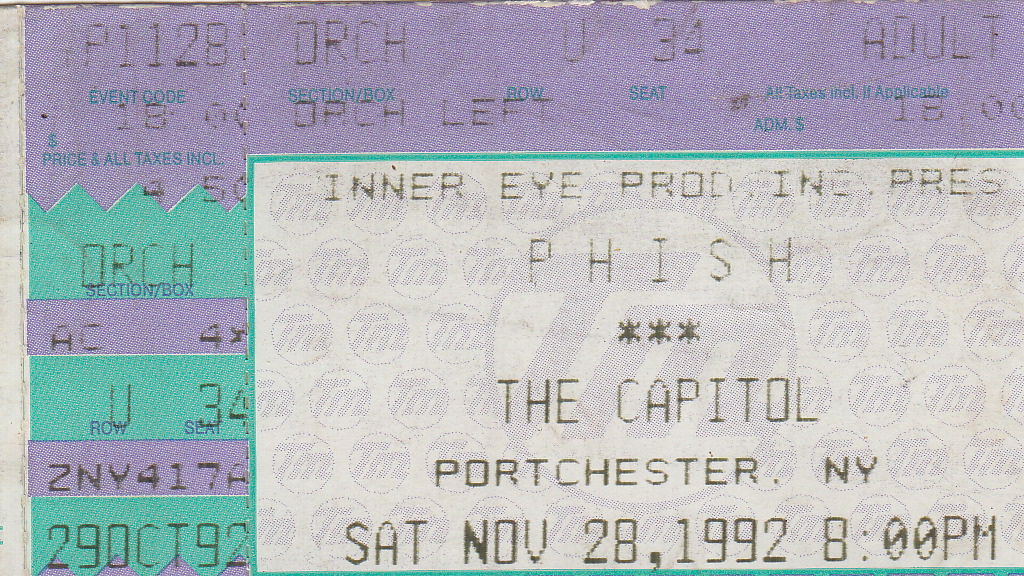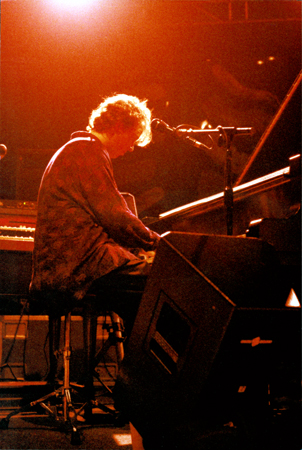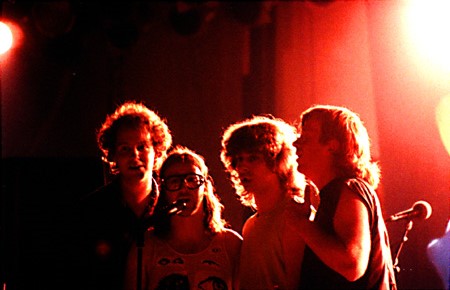FROM THE FORUM 2: "MIKE'S SONG" IN LATE '92 AND "WEEKAPAUG GROOVE" IN EARLY '93
[“From the Forum” is a running blog feature that highlights quality posts from the Phish.net forum to share more broadly. This edition was originally posted by @Flubhead on July 13, 2024. If you would like to listen along to the versions of songs mentioned in this blog post, open the accompanying playlist on phish.in. -Ed.]
The long and rollicking history of the Mike's Groove suite is full of ups, downs, peaks, valleys, and a whole lot of repetition. The first “Mike's Song” that we know of happened on 5/3/1985 at UVM. An auspicious thing, to be born around the same time as the band itself - 5/3/1985 is only the sixth show that we have a recording of. [While the official debut of “Mike’s Song” is listed as 3/16/85, and there is also a version listed in setlists before THAT from 2/1/85, which may be a misidentified tape of 2/3/86, 5/3/85 is indeed the first “Mike’s” that we have on tape.” -Ed.]
The first “I Am Hydrogen” that we have a recording of would appear on 10/15/86 at Hunt's in Burlington. The first performance that we know of was on 4/6/1985, but there's no extant recording of this show as of July 2024. Did its debut predate the actual debut of "Mike's Song"? Another mystery from the early days... It wasn't attached to "Mike's Song" at first. That would happen on 8/29/1987 at The Ranch in Burlington. The first “Hydrogens” seemed to be searching for an appropriate placement in their sets, but it most often preceded the nascent “Who Do? We Do?,” which itself was searching for its appropriate placement.
“Weekapaug Groove, the last piece of the M>I>W puzzle, debuted (we think!) on 7/23/88 at Pete’s Phabulous Phish Phest. “Weekapaug” was preceded by “Hydrogen” in its debut performance; no other song would precede it until 1992, when on 5/14/92 in Port Chester, they played the trifle “Wait” before “Weekapaug.” Clearly weird things were afoot in spring 1992, but dropping “Hydrogen” in favor of some other song preceding “Weekapaug” in the Mike’s Groove suite wouldn’t really begin in earnest until 1993.
Okay, so now that the three puzzle pieces fit together, the band essentially just does a basic reading of M>I>W for the next few years – check out the 5/6/90 show at Toad’s Place in New Haven for what I consider to be the “archetypal” (i.e. most representative) version of the early M>I>W medley.

Things to note about the timings for “Mike’s,” “Hydrogen,” and “Weekapaug” from 1989-1991:
1. “Mike’s” typically would last about 5.5 to 6.5 minutes every time they played it, with a few exceptions here and there where they’d extend the tune by mostly fractional amounts of minutes each time. Obviously, the “second Mike’s jam” would have to wait a few more years to arrive and the band wasn’t going balls-out in pursuit of expansive, patient improv in 1988-1992, but for people who like a nice, uptempo, minor key Type I jam played with fire, verve and precision, these early “Mike’s” can scratch itches for three hot minutes of jamming or so each version
2. “Hydrogen” typically would last a little over two minutes each time – very little variance. Everyone knows this.
3. “Weekapaug” usually lasted between 5.5-7.5 minutes itself. Since as a song, it’s more structurally open than “Mike’s Song,” “Weekapaug” lent itself to more variable song lengths and jamming depths in the early years. As always there are scattered exceptions throughout 1988-1992 (for instance, 3/20/92, an early example of the band starting to stretch out their material: the “Mike’s” reaches over 8 minutes (no JC, but it should have one) and the “Weekapaug” about 10. And the open-ended WG jamming and deconstruction that would blossom in late 1992 and early 1993 is already there in the 3/20/92 Binghamton M>I>W.

Since “Hydrogen” is basically the same thing every time they play it, I'm not going to talk about it that much, other than to note that when I talk about "Mike's Grooves," I COULD be referring to a standard M>I>W format/template for this suite, or I could be referring to any suite of songs that begins with a “Mike's Song” and ends in a “Weekapaug Groove.” 2/20/1993 in Atlanta would see the band interpolating various themes and song snippets throughout its reading of the M>I>W sequence (and in the “Hydrogen” too), and then when April 1993 comes around, it’s off to the races – all of a sudden there’s a novelty replacement for “Hydrogen” (“Great Gig In the Sky”), and a bunch of other various middle tunes were tried out (“Mango Song” and “Contact” being two frequent flyers in that position at the start of this stage of their career). I'm mainly interested in how these two tunes evolved in their infancy and adolescence, notably in the period from March 1992 to August 1993.
The reason for this is that “Mike's” and “Weekapaug” had a kind of twinned gestation during this two-year span, but the timetable seemed to be just slightly off, as “Mike's Song” would begin stretching out regularly in November 1992 (the April 1992 run of “Mike’s Songs” should be heard though: six out of the nine "Mike’s" from April 1992 are jam charted; we would see the song tamed somewhat in the later spring & summer), while “Weekapaug” would suddenly become a vehicle for sheer musical insanity beginning in February 1993.

It's cliché about Phish that song lengths do not necessarily correlate with the quality of the versions – you can have a 23 minute “Piper” that’s boring as hell, or you can have a 7 minute version that just burns from minute one til the firestorm dissipates. Having said that, the average song lengths and the number of Jam Chart entries tell the tale of the growth and trajectories of “Mike’s Song” and “Weekapaug Groove” in this period.
Whereas “Mike’s” used to average 5.5-7 minutes or so pre-1992, beginning in March 1992, we’re seeing versions longer than 7 minutes almost every single time. The average length of a “Mike’s” begins to vary, as does the content of the “Mike’s” jam. There were lots of tease-based jams before 1992, but 1992 is when the teases and secret language stuff starts to really inform the jams and where those jams would go.
For instance, the “Mike’s Song” from 11/19/92 in Colchester, the 11/28/92 Port Chester version, and the one from 12/29/1992 New Haven (Full admission: I was actually at 12/29 at the Palace Theatre! The “Mike’s Song” blew my mind that night.), all three feature tease-based jamming (i.e. an “Under Pressure” tease on 11/19/92 steers the jam toward weird waters, as does a “Walk This Way” tease on 11/28/1992.

On 12/29/92 Trey tries out lots of little lead melodies during Trey’s solo that sound like they’re referencing other songs, but there’s an “On Broadway” tease that develops too, which leads to a “Blue Bayou” tease, then they just abandon “Mike’s Song” completely and launch into a mellow, diffuse version of “Blue Bayou” in the middle of an otherwise-standard-structure Type I jam.
So to my ears, “Mike’s Song” was starting to expand itself in late 1992, opening its structure up to a willingness to lurch in arbitrary directions where it once used to do one thing and one thing only. There was always hot (but short) soloing in “Mike’s Song,” but its scope was reined in; in 1992, now they’re starting to mess with how they’d jam on “Mike’s Song,” which points toward Type II jamming to come.
Meanwhile, “Weekapaug” was itself about to transform, starting in 1992, but really beginning in earnest in February 1993. The transformation was stark and startling. To give you an example of “Weekapaug’s” sudden and very welcome transformation right at the start of 1993, look no further than the song’s stats page on phish.in.
There are 31 versions of “Weekapaug” from 2/4/93 to 5/8/93, and of those only SIX (!!?) are NOT jam-charted. That’s friggin nuts! Some crazy shit was in the air in Spring 1993 (Why don’t you listen to more Spring 1993, BTW? The whole damn tour was on fire). Clearly these whacked-out “Weekapaugs” also point the way toward the flowering of Type II jamming that would begin in August 1993. The Spring “Weekapaugs” are the most direct ancestor of that kind of jamming style, IMO.
The style of jamming found in Spring 1993 “Weekapaugs” is what I like to call “deconstructionist” jamming. They’re messing with the structure of the song, really screwing with dynamics and dissonance, bringing the jam down to silence or noise and building it back up again; opaque and alien melodies pop up for seconds at a time, are partially developed, rhythms are attempted, slowed down, sped up, and discarded, shards of tunes rear ugly heads, and the band goes searching for something novel again between each iteration of the vocal melody.
This is essentially the template they would follow when it came to “Weekapaugs” from here on in, with the added bonus of greater and greater song lengths as the decade wove on. Like I said earlier, the great thing about WG as a jam vehicle is that the song is incredibly open and unstructured.
So what happened in early 1993 that allowed for the creation of so many great and memorable versions of “Weekapaug?” Well, one factor is the single thing most people seem to remember from Spring 1993: Page got hisself a piano! Many of the “Weekapaugs” from this period showcase a pounding, cartoony, frenetic, “Buried Alive”-style piano style, the aggressiveness of which often ends up coloring “Weekapaug” in new and fascinating ways.

Another factor was that Phish was starting to really guide that tease-based style of jamming I talked about above into stranger waters. A great example of this is the very first “Weekapaug” from 1993: 2/4/93 in Providence. Page is just spraying fast flurries of notes everywhere in that frantic “Buried Alive” style, but perfectly in rhythm despite how fast everyone is playing. There are "TMWSIY" quotes. The jam quiets down, gets louder, and then near the end Fishman starts singing “Push Th’ Little Daises” by Ween. We’re already 3/4 of the way to August 1993, IMO.
Really – you literally can’t go wrong choosing a “Weekapaug” from Spring 1993: pert near all of them, just about, should be heard; and they should especially be heard in the context of where the band would start going in the summer; without these “Weekapaugs” to serve as stepping stones toward a new way of making music, who knows if the quantum leap of August 1993 would have happened (sure it would have! Just doing some idle speculation).
Here’s a few more interesting “Weekapaugs” from Spring 1993 that I really enjoy:
2/9/93: This WG from Rochester gets described as “Type II” in its Jam Chart entry, which is a bold claim for pre-August 1993 Phish, but you really should hear this. It’s like 10 minutes of a deep, crazy, Summer 1994 style jam where the band just completely takes apart the structure of a tune, everything from its rhythm and melody to its chord progression, and creates something new, strange, and dissonant out of the stripped parts. The whole version is suffused with tension because it’s obvious not everyone wants to deconstruct the jam, some of them just want a standard reading of the tune. So they keep alternating between brief swatches of “normal” WG-style soloing and brief swatches of deconstruction. This is still a very exciting “Weekapaug” that revels in its own tension and difficulty in a delightful way – and I swear it sounds at least a year and three months ahead of its own time.
3/3/93: Ah, Nawlins. This version directs your attention to incredibly fast playing from Trey during his solo, and it sounds like he’s trying out vocal melodies on his guitar at times (some of these instant melodies are actually pretty catchy). I swear I hear the beginnings of “Down With Disease’s” jam in this Weekapaug. Trey’s soloing gets more and more aggressive and even goofy, with Page chasing and matching his energy in the second solo section. By the 8:30 minute mark, Trey can’t go anywhere but a peak and then it’s over.
3/5/93: They’re not giving anyone a chance to rest. The very next show brings us another great Mike’s Groove, this one episodic and chance-taking. Mike plays with his effects more than usual, there’s tritones and “wrong” notes galore, and the jam seems on the verge of falling apart at times (in an appealing way) were it not for Fishman holding down the fort on drums. This is another jam that sounds for a few minutes like it could have been deposited here from Summer 1994.
3/19/93: It's the big one, Elizabeth! A rightly famous and celebrated WG that winds its way through knotted, dynamic, Type II jamming (I mean, this isn’t even presaging Type II jamming, this IS Type II jamming) and more earthly realms as well for 14 and a half minutes. Not even gonna describe this one, can’t do it justice. Just go hear it ASAP. One of my favorite jams of the band’s entire career.
4/2/93: The JC entry for this show describes it as: “Arguably the most out-there, experimental "Weekapaug" ever, with a blazing return home and vocal jam taboot.” And yeah, this one does get really out there. Type II jamming again, some very experimental sections here. Another 14-minute WG that announces the arrival of Type II improvisation as something one should now expect to hear at a Phish show. Compare this version to ANY “Weekapaug” played before 1992; it's just bizarre and impressive how far they’ve traveled into outer space since then. There’s even some vocal jamming!
As they got more popular, they also got more experimental, which I know wasn’t as beloved an approach to Phish at the time as many people now probably think it was. I recall a couple friends of mine grumbling about “shitty jazz” in 1994 when speaking about Phish, and I think they must have been referring to these more out-there types of jams, because this is yet another version that sounds ahead of its time.
So yeah, to wrap up: if you’re not already well acquainted with the joys of the Mike’s Groove combo as it sounded in 1992-1993, you owe it to yourself to seek out some of these versions, because they’re a lot more fascinating than their pre-August 1993 status would indicate. And then go check out a bunch of other Spring 1993 shows!
Comments
You must be logged in to post a comment.


 The Mockingbird Foundation
The Mockingbird Foundation